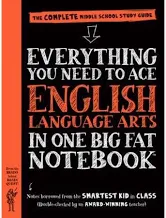Speaking English in Content Marketing
“This big fat notebook makes all the stuff you learn in school sink in,” the editors of The Complete Middle School Study Guide to English Language Arts promise. “Words don’t exist in a vacuum out in space, the authors explain. Sometimes we can only understand what they mean because of the other words around them..”As a content writer, I found the author’s list of word relationships might serve as a checklist of ideas for different ways of presenting information in blog posts (adapting the sophistication level, of course, to the target audience)
Cause/effect
“I wanted a new bike because I saw the one Carlos had.”‘
A small business owner’s or a professional practitioner’s business blog marketing can have a disproportionately positive effect on results – IF those efforts are kept up. On the other hand, spelling and grammar errors in emails and blog posts will have a negative effect on readers’ perception of your company.
Compare/contrast
“You’re about to introduce your brother to a new friend. To give him an idea of what that friend might be like, you might say either ‘He’s just like Chris’ or ‘He’s nothing like Chris'”.
A unique selling proposition (USP) is a succinct, memorable message that identifies the unique benefits that are derived from using your product or service as opposed to a competitor’s, business coach Andrew Valley emphasizes.
Analogy
“A student is to a new topic like a detective is to a case.” “A tree is to a forest like a boat is to an ocean.”
As you set about explaining yourself, your business philosophy, your products and processes , to make the information you’re presenting in blog posts easy for readers to understand by comparing the unfamiliar with the familiar and the timely.
Contrasting characters in books and plays
“One way a writer develops characters is to contrast them so the reader can see their differences”
There’s something of a moral dilemma in content marketing . We want to clarify the ways we stand out from the competition, but “Golden Rule” ethics dictate that we say only those kinds of things about specific competitors that we’d want them saying about us. The solution: accentuate the positive, explaining why you have chosen to do things the way you do,
The Little Fat Notebook is a good reminder to “Speak English” in your content marketing!






Follow us online!